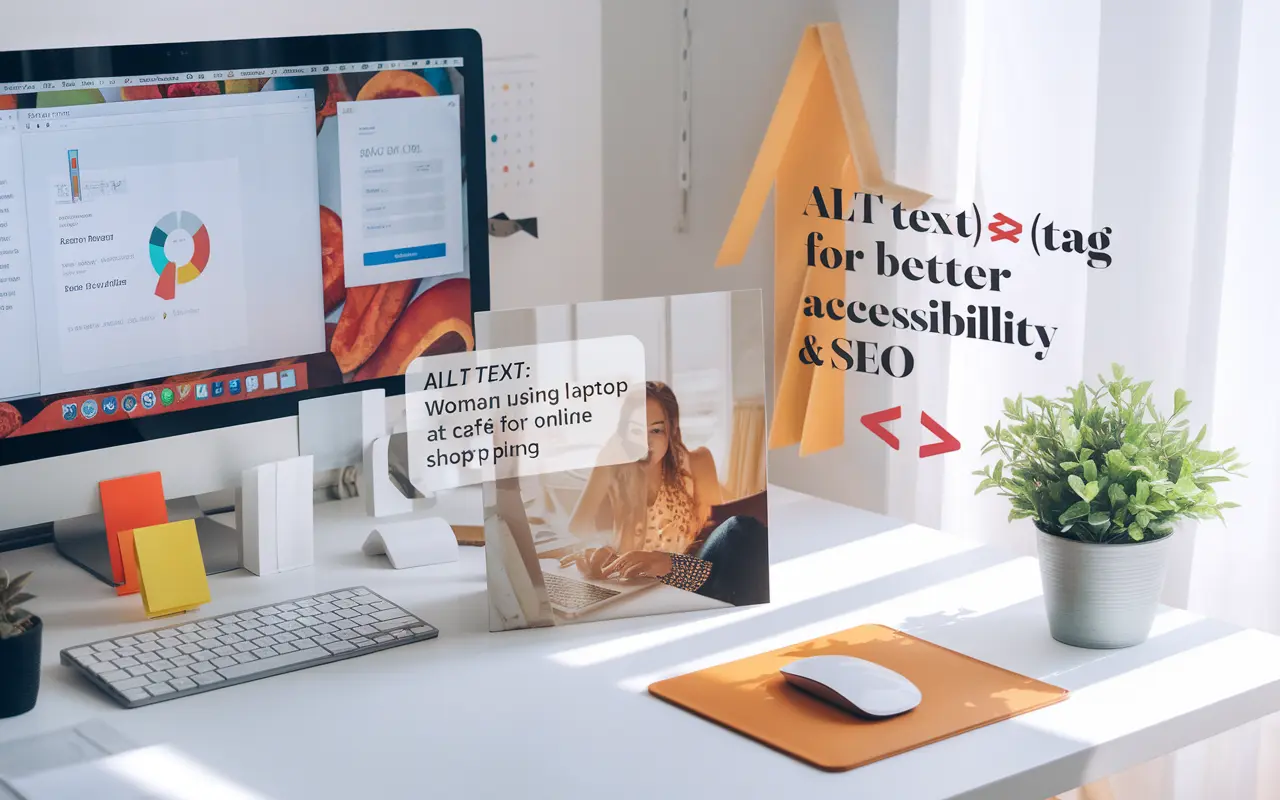What is Alt Text (Alt Tag)?
Alt Text, also known as an Alt Tag, is a written description added to images within HTML code to help screen readers and search engines understand the content of the image. While invisible to most users, it plays a vital role in SEO and web accessibility. When images fail to load or need to be interpreted by assistive technologies, the alt text communicates what the image is about.
In SEO services, Alt Text improves a site’s organic visibility by making content more interpretable to search engines. It’s a foundational element of on-page SEO that contributes to image rankings and broader search engine indexing strategies.
Definition
Alt Text (or Alternative Text) is an HTML attribute used inside an <img> tag to provide a textual description of the image’s appearance or function. It enhances user experience for people with visual impairments and ensures that content remains understandable even when images are not displayed. For example:
<img src="product.jpg" alt="Red cotton T-shirt with white stripes">
This provides both meaning for the image to assistive technologies and contextual signals for search engine crawlers.
Key Takeaway
Alt Text (Alt Tag) boosts SEO by making images discoverable in search engines, enhancing accessibility for visually impaired users, and supporting page relevance and keyword strategies.
Importance for SEO
Alt Text is a hidden gem in the world of SEO. Far more than a technical SEO checkbox, it directly affects how your visuals rank on platforms like Google Images, which is a significant traffic source for many businesses. Additionally, it improves overall page relevance by reinforcing keyword themes and helps crawlers better index your site content.
Businesses that leverage proper alt text enjoy better user engagement, improved bounce rates, greater image SEO visibility, and enhanced accessibility compliance, especially for ADA and WCAG standards—all of which can directly or indirectly improve conversion rates and ROI.
Best Practices
- Be Descriptive: Clearly describe what the image portrays without being overly verbose.
- Use Relevant Keywords: Integrate SEO keywords naturally when they are contextually appropriate.
- Avoid Keyword Stuffing: Using too many keywords can be seen as manipulative by search engines.
- Be Specific: Focus on crucial details like color, model, or product name when applicable.
- Don’t Say “Image of” or “Picture of”: Screen readers already identify it as an image, so redundancy hurts clarity.
- Use Empty Alt Text for Decorative Images: For images that are purely aesthetic, use alt=”” to keep the experience smooth for assistive users.
- Maintain Consistency: Standardize practices across site images to maintain quality and searchability.
How Alt Text (Alt Tag) Works
Alt Text functions by sitting within the <img> element in your website’s HTML structure. When an image is rendered, the alt tag is only visible if the image doesn’t load or when a screen reader scans the page.
Search engine bots rely on alt text to understand the content and purpose of images. Without it, images remain invisible to crawlers, leaving a content and keyword gap in your SEO strategy.
For example, an eCommerce business selling “black leather boots” can rank better in Google Images or universal SERPs when the product image has descriptive, keyword-rich alt text.
| Image Type | Good Alt Text | Bad Alt Text |
|---|---|---|
| Product | “Men’s brown leather Oxford shoes with brogue design” | “shoes123” |
| Graph | “Monthly sales revenue chart for Q1 2024 showing 35% growth” | “chart.jpg” |
| Logo | “Digidream Marketing Agency Logo” | “logo” |
| Decorative Banner | “” (empty alt text) | “banner photo” |
Case Study: Boosting Ecommerce Visibility Through Effective Alt Text
Problem: Images Not Ranking in Search
A fashion-focused eCommerce store noticed that despite having high-quality product photos, they were receiving minimal traffic from Google Images. The pages were optimized with keywords, but image visibility was lacking.
Solution: Implementing Strategic Alt Text
Our SEO team audited the site and rewrote image tags with properly optimized alt text, incorporating product-specific keywords with descriptive language. They also removed redundant or generic alt tags and implemented empty tags for purely decorative images.
Results: Increased Image Traffic by 76%
In three months, the website saw a 76% increase in image-based traffic and better rankings on product-related image searches. Conversions also improved as a result of better visibility in both regular and visual search results.
Common Mistakes to Avoid
- Keyword Stuffing: Overloading your alt text with keywords reduces readability and may trigger penalties.
- Leaving Alt Text Blank (When It Matters): Neglecting alt tags for functional images (like CTAs or product visuals) wastes SEO potential.
- Using File Names Instead of Descriptions: Alt=”image1.jpg” does nothing for SEO or accessibility.
- Being Too Vague: Alt=”image” or “picture” doesn’t describe the image content at all.
Related Terms
Explore terms related to Alt Text (Alt Tag) for broader SEO understanding:
- Image Optimization: Techniques like compressing images, naming files correctly, and adding alt tags for better web performance and SEO.
- On-Page SEO: Core SEO tasks applied directly on your website, including content, image tags, and HTML optimization.
- Technical SEO: Backend elements that help search engines crawl and index your website effectively.
Conclusion
Alt Text (Alt Tag) is more than an accessibility feature—it’s a subtle but powerful component of on-page SEO that contributes to better indexing, user experience, and image search visibility. By writing descriptive, keyword-relevant alt tags for your images, you support both human users and search engine algorithms. Take this step seriously and ensure you’re not missing out on valuable traffic, credibility, and conversions.
For further insights and implementation support, visit our SEO services page and explore additional resources to elevate your digital presence.





